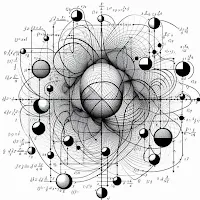Dadas las siguientes ecuaciones de estado o ecuaciones diferenciales (pasar a ecuación de estado con variables de fase) con condiciones iniciales, (i) calcular manualmente los valores y vectores propios; (ii) obtener la matriz de transición del estado y comprobar algunas de sus propiedades (si no se cumplen debe haber un error en la solución hallada); (iii) obtener la solución analítica de la ecuación con la entrada que se indica; (iv) comparar con MATLAB la solución obtenida con la solución simulada utilizando la función lsim; (v) comprobar el cálculo de los valores y vectores propios con la funciones eig o jordan (si hay vectores propios generalizados) de MATLAB.
- $\dot{\mathbf{x}}=\left[\begin{matrix}2&3\\2&1\\ \end{matrix}\right] \mathbf{x},\mathbf{x}(0)=\left[ \begin{array}{c}1\\1\\ \end{array} \right] $
- $\dot{\mathbf{x}}=\left[\begin{matrix} -4& 1& 1\\ 1& 5& -1\\ 0& 1& -3\\\end{matrix} \right] \mathbf{x},\mathbf{x}(0)=\left[ \begin{array}{c} 1\\ 0\\ 1\\ \end{array} \right] $
- $\dot{\mathbf{x}}=\left[\begin{matrix} 1& -2& 2\\ -2& 1& -2\\ 2& -2& 1\\ \end{matrix}\right] \mathbf{x},\mathbf{x}(0)=\left[ \begin{array}{c} 1\\ -1\\ 0\\ \end{array}\right] $
- $\dot{\mathbf{x}}=\left[ \begin{matrix} 3& -18\\ 2& -9\\\end{matrix}\right] \mathbf{x},\mathbf{x}(0)=\left[ \begin{array}{c} 1\\ -1\\ \end{array}\right]$
- $\dot{\mathbf{x}}=\left[\begin{matrix} 2& 1& 6\\ 0& 2& 5\\ 0& 0& 2\\\end{matrix}\right] \mathbf{x},\mathbf{x}(0)=\left[ \begin{array}{c} 0\\ -1\\ 1\\ \end{array} \right] $
- $\dot{\mathbf{x}}=\left[ \begin{matrix} 2& 8\\ -1& -2\\ \end{matrix}\right] \mathbf{x},\mathbf{x}(0)=\left[ \begin{array}{c} 1\\ 0\\ \end{array}\right] $
- $\dot{\mathbf{x}}=\left[ \begin{matrix} 2& 3\\ 2& 1\\ \end{matrix} \right] \mathbf{x}+\left[ \begin{array}{c} 1\\ -1\\\end{array} \right]u,u=1,\mathbf{x}(0)=\left[\begin{array}{c} 0\\ 1\\\end{array} \right] $
- $\dot{\mathbf{x}}=\left[ \begin{matrix} 2& 3\\ 2& 1\\ \end{matrix} \right] \mathbf{x}+\left[ \begin{array}{c} 1\\ -1\\\end{array}\right]u,u=1,\mathbf{x}(0)=\left[\begin{array}{c} 1\\ -1\\\end{array} \right] $
- $\dot{\mathbf{x}}=\left[ \begin{matrix} 2& 3\\ 2& 1\\ \end{matrix}\right] \mathbf{x}+\left[ \begin{array}{c} 1\\ -1\\\end{array}\right]u,u=\delta (t-2),\mathbf{x}(0)=\left[\begin{array}{c} 1\\ -1\\\end{array}\right] $
- $\dot{\mathbf{x}}=\left[\begin{matrix} 0& 1\\ -1& 0\\ \end{matrix}\right]\mathbf{x}+\left[ \begin{array}{c} 0\\ 1\\\end{array} \right]u,u=1,\mathbf{x}(0)=\left[\begin{array}{c} 1\\ 0\\\end{array} \right] $
- $\dot{\mathbf{x}}=\left[ \begin{matrix} 0& 1\\ -1& 0\\ \end{matrix} \right] \mathbf{x}+\left[ \begin{array}{c} 0\\ 1\\ \end{array} \right]u,u=\delta (t),\mathbf{x}(0)=\left[ \begin{array}{c} 1\\ 0\\ \end{array}\right] $
- $\dddot{y}=u,u=\delta \left( t-1 \right) ,y(0)=1,\dot{y}(0)=0,\ddot{y}(0)=0$
- $\overset{(4)}{y}+5+6\ddot{y}=u,\mathrm{ }u=1,y(0)=\dot{y}(0)=1,\ddot{y}(0)=(0)=0$
- $\dot{\mathbf{x}}=\left[\begin{matrix} -0.0197& 0\\ 0.0178& -0.0129\\ \end{matrix} \right] \mathbf{x}+\left[ \begin{array}{c} 0.0263\\ 0\\ \end{array} \right]u,u=1,\mathbf{x}(0)=\left[ \begin{array}{c} 0\\ -1\\\end{array} \right] $
- $\dot{\mathbf{x}}=\left[ \begin{matrix} 0& 1\\ 0& 0\\\end{matrix} \right] \mathbf{x}+\left[ \begin{array}{c} 0\\ 1\\ \end{array} \right]u,u=1,\mathbf{x}(0)=\left[ \begin{array}{c} 0\\ 1\\\end{array} \right] $
- $\dot{\mathbf{x}}=\left[ \begin{matrix} 2& 3\\ 2& 1\\ \end{matrix} \right] \mathbf{x}+\left[ \begin{array}{c} 1\\ -1\\ \end{array} \right]u(t-2),u=u_s(t),\mathbf{x}(0)=\left[ \begin{array}{c} 1\\ 0\\\end{array} \right] $
- $\dot{\mathbf{x}}=\left[ \begin{matrix} 2& 3\\ 2& 1\\ \end{matrix} \right] \mathbf{x}+\left[ \begin{array}{c} 1\\ -1\\ \end{array} \right]u(t-0.6),u=u_s(t),\mathbf{x}(0)=\left[ \begin{array}{c} 1\\ 0\\\end{array}\right] $
- $\dot{\mathbf{x}}=\left[ \begin{matrix} 2& 3\\ 2& 1\\ \end{matrix} \right] \mathbf{x}+\left[ \begin{array}{c} 1\\ -1\\\end{array} \right]u(t-1.5),u=u_s(t),\mathbf{x}(0)=\left[ \begin{array}{c} 1\\ 0\\\end{array} \right] $
- $\dot{\mathbf{x}}=\left[\begin{matrix} 1&0\\ 1&1\\ \end{matrix}\right] \mathbf{x}+\left[ \begin{array}{c} 1\\ 0\\\end{array}\right]u(t-4),u=u_s(t),\mathbf{x}(0)=\left[\begin{array}{c} 0\\ 1\\ \end{array} \right] $
- $\dot{\mathbf{x}}=\left[ \begin{matrix} 1& 0\\ 1& 1\\ \end{matrix} \right] \mathbf{x}+\left[ \begin{array}{c} 1\\ 0\\ \end{array} \right]u(t-0.8),u=u_s(t),\mathbf{x}(0)=\left[ \begin{array}{c} 0\\ 1\\\end{array} \right] $
- $\dot{\mathbf{x}}=\left[ \begin{matrix} 1& 0\\ 1& 1\\ \end{matrix} \right] \mathbf{x}+\left[ \begin{array}{c} 1\\ 0\\\end{array} \right]u(t-0.8),u=u_s(t),\mathbf{x}(0)=\left[ \begin{array}{c} 0\\ 1\\\end{array} \right] $

Comentarios